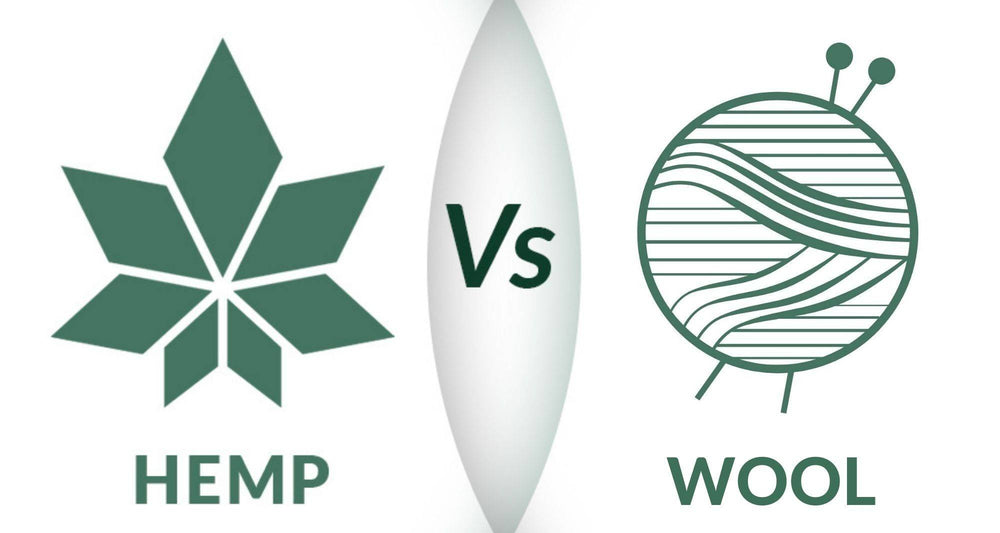
Hemp vs Wool: How Do They Compare?
|
If you're not happy with your first pair of underwear after trying it on, let us know.
We'll send a new size or color, or give you a refund. No returns needed.

Katie Lemon
|
In the case of hemp vs wool, these two natural fibers both have their place in environmentally-friendly clothing. Both hemp and wool have self-cleaning properties, which makes for fantastic antibacterial underwear. Just like hemp wool is one of the most sustainable fabrics you can find, as they’re made from natural sources and are completely biodegradable.
But what sets them apart? We’ve compared hemp vs cotton, hemp vs linen, and hemp vs bamboo. Now it’s time to evaluate how hemp stacks up against wool. Keep reading to find out what makes each fiber source so different from one another.
From raising sheep to treating the eventual fibers, producing wool takes a lot more resources to make than hemp. First, sheep consume a lot of food and water and have to be cleaned, maintained, and treated for medical needs. Not to mention, sheep produce heavy amounts of methane waste: up to 30 liters per sheep a day!
On the other hand, hemp grows like a weed and doesn’t require copious amounts of water or energy to produce a sizable crop. Plus, hemp can be processed with dew retting, which uses naturally occurring dew and rainfall to soften fibers.
Wool is harvested from sheep using harmful chemicals, with sheep sometimes even being dipped into pesticide baths. Not only is this super inhumane to the sheep, but the pesticides can be toxic to farmers and pollute waterways. PETA has even started a campaign against wool, with video evidence of farmers in the US and Australia mistreating and even injuring sheep during the shearing process.
Luckily, hemp can be grown and produced entirely without pesticides, harming animals, or harming people. Hemp grows so prolifically that it smothers other weeds in the process, making herbicides totally unnecessary. In fact, no chemicals at all have to be used to make hemp fabric. This protects worker health and the earth at the same time.
In order to have enough land to raise industrial livestock, farmers must clear land. This in turn degrades the natural environment by increasing greenhouse gases and eliminating biodiversity. This is the case for any livestock grazing, and sheep are no different. There are more sustainable land management practices being put into place on a small scale, but they’ve yet to become widespread.
Unlike wool, growing hemp actually has a net positive effect on the environment. Check out just a few of the ways hemp improves the earth while it’s growing:
Prevents erosion: Hemp root networks grow up to nine feet long. Because of their size and shape, these root systems help to fight soil compaction and erosion.
Increases biodiversity: Hemp draws in a variety of insects for pollination and altogether improves regional biodiversity. This in turn helps safeguard food security and contributes to sustainable agricultural practices. Not bad!
Removes toxins from soil: Not only does hemp improve soil health overall, it even removes toxic substances from soil through a process called “phytoremediation.”
While both hemp and wool help to regulate your body temperature, hemp is breathable enough to be worn all year round. It's a lightweight fabric that you can comfortably wear while exercising in the heat or while traversing to work in the chilliest of weather. Hemp has remarkable insulation properties, so you can be sure you’ll stay nice and warm while layered up in this wonderful fabric.
Unlike hemp wool isn’t the best fabric for wearing all-year round. Can you imagine throwing on a wool top in summer? Doesn’t sound very comfortable to me. The best wool you could possibly wear in the summer heat is merino wool thanks to it’s lighter feel and weave. When looking into Merino Wool brands, you must research companies who work with non-mulesed sheep. Mulesing is a painful process carried out on sheep to prevent Flystrike. Yikes!
If you own a wool sweater you know exactly what I’m talking about: this fabric is often itchy and rough against bare skin, while hemp is the exact opposite. Most hemp fabric is blended with eco-friendly fibers like organic cotton to become super soft and malleable.
Where you’ll almost always want to wear an extra layer of clothing between wool and your skin, hemp can be worn on even your most sensitive parts, like as high waisted underwear or a triangle bralette. Even better? Hemp actually gets softer every time you wash it. The fabric breaks in beautifully without sacrificing comfort along the way.
There are a whole litany of factors that make wool wear out faster than hemp, including:
Wool felts easily: Expose this fabric to high heat or moisture and it changes texture completely.
Wool weakens when wet: Wool becomes weaker each time it’s exposed to water, which makes it much more difficult to wash often enough to stay clean.
Wool attracts moths: You don’t want these pesky insects anywhere near your clothing. When moths cozy up to your wool they chew unsightly holes through the fabric that could be the demise of your duds.
When clothing wears out faster, it means you’ll be spending more money and replacing your closet staples more often. All that worn wool will go straight to the landfill whereas hemp lasts much longer. Hemp fibers are actually some of the strongest in the world, so you don’t have to worry about tossing your hemp clothes from the host of issues that wool is prone to.
Wool clothing requires a lot more energy (and money!) to maintain than hemp. That’s because wool fabric is a bit fussy and often needs to be dry cleaned rather than put through a normal wash cycle. Not only is this expensive, but dry cleaning uses chemical solvents that leach into the air and pollute the environment. Yikes!
Thankfully, hemp can be washed with the rest of your clothes, saving you time and money when it comes to upkeep. Typically, as long as you use a gentle wash cycle and tumble dry low, you’ll be good to go. For delicates, keep your hemp goods lasting even longer by learning how to hand wash underwear sustainably.
In the case of hemp vs wool, both of these natural fibers have their place in a well-rounded sustainable closet. Wool is a great insulator, making it perfect for staying warm in cold weather. But when it comes to overall durability and eco-friendliness, you can’t go wrong with hemp.
For natural, organic clothing that’s good for the earth, why not try a hemp racerback bralette or cozy men’s trunks? Your body and the earth will thank you.
Did you know how hemp stacked up against wool? What’s your favorite natural fiber to wear? Let me know what you think in the comments!
Get updates on restocks, new color and size releases, and upcoming product launches. You’ll also get a 15% discount on your first order of hemp underwear.










